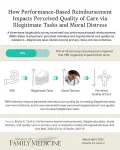(Press-News.org) Mutations in the BRCA1 gene that are either inherited (germline) or acquired (somatic) might not be key to the initiation of prostate cancer, as previously thought, suggests the first study of its kind, published online in the open access journal BMJ Oncology.
If confirmed in further studies, the findings suggest that it may be time to reassess current treatment with PARP (poly(ADP-ribose) polymerase) inhibitor drugs, which block the ability of cells, including cancer cells, to repair DNA damage, in men with BRCA1 genetic variants, say the researchers.
A linked editorial suggests that the findings pave the way for greater refinement of genetic testing and personalised treatment for men with prostate cancer.
Prostate cancer is the most common cancer in men, and genetic variants in DNA damage repair and response genes are known to have a role in disease progression.
For example, men with inherited or acquired mutations in BRCA2 or ATM genes are at heightened risk of aggressive disease and have worse outcomes than those who don’t have these mutations, explain the researchers.
To try and quantify the contribution of inherited and acquired mutations in different DNA repair and response genes in men with prostate cancer, the researchers reviewed the genetic test results of 450 men with the disease in North West England between 2022 and 2024.
The men had either been tested for germline (166), somatic (280), or both types (4) of genetic variants of BRCA1, BRCA2, ATM, CDK12, and PALB2 genes, with a view to starting them on PARP inhibitor treatment.
In 340 cases, the men’s cancer had spread elsewhere (metastasised). Their average age was 69, but ranged between 38 and 87.
Among those in this group who weren’t tested, based on high risk—age or family history—at least 18 (just over 5%) had a germline BRCA2 variant, but only 1 had a germline BRCA1 (0.3%) variant. And of the 263 screened for germline ATM variants, 7(3%) tested positive.
Among the 124 undergoing germline testing based on high risk, their average age was 56 (range 34–77). Again, germline BRCA2 variation predominated, with 8 (8%) testing positive, but only one (less than 1%) testing positive for a germline BRCA1 variant.
Germline BRCA 1 and BRCA 2 test results were available for all 450 men. These revealed 27 germline BRCA2 variants (6%), but only 2 germline BRCA1 variants (0.5%), and one of these probably wasn’t the driver as an ATM mutation was also present, note the researchers.
Six ATM germline variants were found among the 328 men tested for this genetic mutation. And among the 97 men tested for germline PALB2 variants just 1 was found in a man in his 70s with a strong family history of breast cancer.
Of those tested for CHEK2 (122), for Lynch (69), or for RAD51C/D (15) genetic mutations, none was found.
Somatic test results were available for 280 men whose cancer had spread elsewhere. Overall, 31 (11%) had an identifiable BRCA2 genetic variant. Of these, 16 (6%) were confirmed germline and 11 (4%) were confirmed somatic. Variant type was unclear in 4.
This indicates that BRCA2 variants, somatic and germline, have a major role in prostate cancer progression affecting at least 1 in 10 carriers with the disease, say the researchers.
BRCA1 variants, on the other hand, don’t seem to be major contributors to disease initiation or progression, with only 1 somatic variant and 1 germline variant found in combination with a germline ATM variant in one case where the disease had spread elsewhere.
Both germline and somatic ATM mutations were also associated with disease spread as 16 out of the 263 (6%) tumour samples tested had an ATM genetic variant identified, 5 (2%) of which were germline, 7 (2.5%) of which were somatic, while 4 were indeterminate.
And the data suggest that somatic CDK12 and somatic and germline BRCA2 should no longer be considered mutually exclusive, as they have been previously.
The researchers acknowledge that only 217 tumour samples were tested for all genetic variants, and that they were unable to classify all those identified as either somatic or germline. And as the BRCA1 variant carriers were tested relatively recently, the longer term outcomes for these men aren’t yet known, they point out.
“Even if there is a signal for non-metastatic prostate cancer in BRCA1, this may not justify PSA [prostate specific antigen] screening, given the high rates of overdiagnosis,” say the researchers.
“It may be time, therefore, to question whether BRCA1 should be considered to be a prostate cancer predisposing gene, given its very low prevalence in the present study of somatic mutations,” they suggest.
In a linked editorial, Drs Fumihiko Urabe and Kosuke Takemura, of, respectively, The Jikei University School of Medicine, Minato, Japan, and The Cancer Institute Hospital of JFCR, Tokyo, Japan agree that treatment options may need to be revised in light of the study findings.
“[They] reinforce the role of BRCA2 and ATM as key determinants of aggressive prostate cancer phenotypes. The limited involvement of BRCA1 suggests that tumours harbouring BRCA1 variants may not rely on homologous repair deficiency, potentially limiting their responsiveness to PARP [inhibitor]-based therapies,” write the authors.
They add: “CDK12 mutations, previously considered mutually exclusive with BRCA2, were observed in conjunction with BRCA2 mutations, suggesting a potential for dual targeted therapies combining PARP [inhibitors] and immunotherapy.”
And conferring the same potential for aggressive disease on both BRCA1 and BRCA2 is probably no longer appropriate, they suggest.
“Although many prior clinical studies have categorised BRCA1 and BRCA2 mutations together as a single group (BRCA1/2), this research leads to the conclusion that BRCA1 and BRCA2 should be analysed separately,” they say.
“If post hoc analyses of previous clinical trials that grouped BRCA1/2 mutations reveal differing therapeutic effects, it may necessitate reevaluating the interpretation of BRCA1 and BRCA2 mutations in prostate cancer,” they add.
Although further research in more diverse groups of patients is warranted, the study findings “pave the way for refining genetic testing strategies and personalised treatment approaches in prostate cancer,” they conclude.
END
BRCA1 gene mutations may not be key to prostate cancer initiation, as previously thought
May be time to reassess use of PARP inhibitor drugs in these patients, say researchers. Findings pave way for refining genetic testing and personalised treatment in prostate cancer
2025-02-25
ELSE PRESS RELEASES FROM THIS DATE:
Melatonin supplementation may help offset DNA damage linked to night shift work
2025-02-25
Melatonin supplementation may help offset the DNA damage associated with night shift work by boosting the body’s ability to repair it, suggest the findings of a small clinical trial published online in the journal Occupational & Environmental Medicine.
Larger studies looking at varying doses and the potential long term effects of melatonin supplementation are now warranted, conclude the researchers.
Normal night-time production of the body clock hormone, melatonin, is suppressed in night shift workers. This compromises the body’s ability to repair oxidative DNA damage, the by-product of normal cellular processes, heightening the risk of ...
Common gynaecological disorders linked to raised heart and cerebrovascular disease risk
2025-02-25
Having one or more common gynaecological disorders, such as endometriosis or heavy or irregular periods, may be linked to a heightened risk of heart disease and conditions that affect blood flow to the brain (cerebrovascular disease), finds a pooled data analysis of the available evidence published online in the journal Heart.
Although the quality of the studies included in the analysis was variable, the researchers nevertheless conclude that clinicians and the public need to be more aware of these associations to potentially mitigate the risks.
Long term non-cancerous gynaecological disorders ...
Nerve fibers in the inner ear adjust sound levels and help compensate for hearing loss in mice, study finds
2025-02-25
The brain may play a role in helping the ear regulate its sensitivity to sound and compensate for hearing loss by sending a signal to a structure in the inner ear known as the cochlea, according to a study that was just published in the Journal of Neuroscience. The discovery could help researchers develop treatments for tough-to-treat hearing disorders such as hyperacusis, where everyday sounds seem uncomfortably loud, and tinnitus, a sensation of ringing, buzzing or other sound in the ear when there is no external source.
The findings were powered by a new ...
ECMWF – Europe’s leading centre for weather prediction makes forecast data from AI model available to all
2025-02-25
Embargo: 25 February 2025 00.01 AM GMT
ECMWF – Europe’s leading centre for weather prediction makes forecast data from AI model available to all
A newly operational model, known as the Artificial Intelligence Forecasting System (AIFS), has been launched by the European Centre for Medium-Range Weather Forecasts (ECMWF), an intergovernmental centre and leader in numerical weather prediction. For many measures including tropical cyclone tracks, the AIFS outperforms state-of-the-art physics-based models, with gains ...
New paper-based device boosts HIV test accuracy from dried blood samples
2025-02-24
In parts of the world where traveling to a clinic for routine blood tests is a financial and logistical challenge, HIV patients increasingly have the option to collect and ship a drop of their blood in paper-based devices that absorb the sample and store it for analysis in far-away labs.
While this technology is helpful for tracking someone’s adherence to their drug regimen or monitoring disease progression, the most frequently used devices don’t control how much blood they collect, potentially leading to inaccurate readings of a person’s infection.
Understanding this limitation, Charlie Mace, an associate professor at Tufts University’s ...
Pay-for-performance metrics must be more impactful and physician-controlled
2025-02-24
Pay-for-Performance Metrics Must Be More Impactful and Physician-Controlled
Background: This editorial builds on a study by Brulin and Teoh, released ahead of the March/April 2025 issue of Annals of Family Medicine, which found that performance-based reimbursement is associated with lower perceived quality of care by increasing illegitimate tasks and moral distress for primary care physicians.
Editorial Stance: Quality metrics and pay-for-performance initiatives are far more expensive than many patients, clinicians, or administrators realize. The authors call for more rigorous review through cluster randomized controlled trials both before and after implementation—and ...
GLP-1RAs may offer modest antidepressant effects compared to DPP4is but not SGLT-2is
2025-02-24
Follow @Annalsofim on X, Facebook, Instagram, threads, and Linkedin
Below please find summaries of new articles that will be published in the next issue of Annals of Internal Medicine. The summaries are not intended to substitute for the full articles as a source of information. This information is under strict embargo and by taking it into possession, media representatives are committing to the terms of the embargo not only on their own behalf, but also on behalf of the organization they represent.
----------------------------
1. ...
Performance-based reimbursement increases administrative burden and moral distress, lowers perceived quality of care
2025-02-24
Performance-Based Reimbursement Increases Administrative Burden and Moral Distress, Lowers Perceived Quality of Care
Background and Goal: Performance-based reimbursement (PBR) is a payment system in which clinics receive compensation based on the quality and outcomes of care they deliver, rather than the volume of services provided. Although designed to improve efficiency and effectiveness, the growth of PBR systems has been linked to increased administrative work for physicians. This study examined how PBR affects doctors' perceived ability to provide quality ...
Survey finds many Americans greatly overestimate primary care spending
2025-02-24
Survey Finds Many Americans Greatly Overestimate Primary Care Spending
Background and Goal: This study, based on an online survey of 1,135 adults demographically representative of the U.S. population, aimed to measure public perceptions of primary care spending.
Key Insights: Respondents believed that 51.8% of overall health care spending goes to primary care—more than 10 times the documented share of 4.7%. Additionally, respondents believed that primary care addresses 58.7% of health care needs, very close to actual primary care utilization as a percentage of all ambulatory physician ...
Researchers advance RNA medical discovery decades ahead of schedule
2025-02-24
Ribonucleic acid, commonly known as RNA, is involved in many biological functions, and some, including gene silencing, are utilitized to cure diseases. RNA has recently gained attention as a promising drug target. Unfortunately, only a small fraction of RNA structures have been determined experimentally, and the process of uncovering these structures requires significant time and effort. Using this time scale, the structures of many life saving RNA may not be discovered for years. As a result, there is a significant gap between the types of known ...
LAST 30 PRESS RELEASES:
Pure bred: New stem cell medium only has canine components
Largest study of its kind highlights benefits – and risks – of plant-based diets in children
Synergistic effects of single-crystal HfB2 nanorods: Simultaneous enhancement of mechanical properties and ablation resistance
Mysterious X-ray variability of the strongly magnetized neutron star NGC 7793 P13
The key to increasing patients’ advance care medical planning may be automatic patient outreach
Palaeontology: Ancient tooth suggests ocean predator could hunt in rivers
Polar bears may be adapting to survive warmer climates, says study
Canadian wildfire smoke worsened pediatric asthma in US Northeast: UVM study
New UBCO research challenges traditional teen suicide prevention models
Diversity language in US medical research agency grants declined 25% since 2024
Concern over growing use of AI chatbots to stave off loneliness
Biomedical authors often call a reference “recent” — even when it is decades old, analysis shows
The Lancet: New single dose oral treatment for gonorrhoea effectively combats drug-resistant infections, trial finds
Proton therapy shows survival benefit in Phase III trial for patients with head and neck cancers
Blood test reveals prognosis after cardiac arrest
UBCO study finds microdosing can temporarily improve mood, creativity
An ECOG-ACRIN imaging study solves a long-standing gap in metastatic breast cancer research and care: accurately measuring treatment response in patients with bone metastases
Cleveland Clinic presents final results of phase 1 clinical trial of preventive breast cancer vaccine study
Nationally renowned anesthesiology physician-scientist and clinical operations leader David Mintz, MD, PhD, named Chair of the Department of Anesthesiology at the UM School of Medicine
Clean water access improves child health in Mozambique, study shows
Study implicates enzyme in neurodegenerative conditions
Tufts professor named Fellow of the National Academy of Inventors
Tiny new device could enable giant future quantum computers
Tracing a path through photosynthesis to food security
First patient in Arizona treated with new immune-cell therapy at HonorHealth Research Institute
Studies investigate how AI can aid clinicians in analyzing medical images
Researchers pitch strategies to identify potential fraudulent participants in online qualitative research
Sweeping study shows similar genetic factors underlie multiple psychiatric disorders
How extreme weather events affect agricultural trade between US states
Smallholder farms maintain strong pollinator diversity – even when far from forests
[Press-News.org] BRCA1 gene mutations may not be key to prostate cancer initiation, as previously thoughtMay be time to reassess use of PARP inhibitor drugs in these patients, say researchers. Findings pave way for refining genetic testing and personalised treatment in prostate cancer



